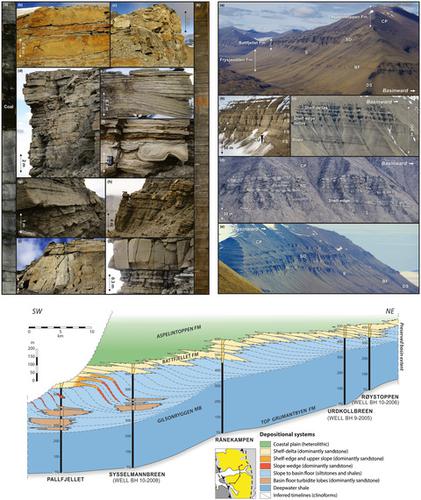当前位置:
X-MOL 学术
›
Basin Res.
›
论文详情
Our official English website, www.x-mol.net, welcomes your feedback! (Note: you will need to create a separate account there.)
The Svalbard Eocene‐Oligocene (?) Central Basin succession: Sedimentation patterns and controls
Basin Research ( IF 3.2 ) Pub Date : 2020-07-12 , DOI: 10.1111/bre.12492 William Helland‐Hansen 1, 2 , Sten‐Andreas Grundvåg 3
Basin Research ( IF 3.2 ) Pub Date : 2020-07-12 , DOI: 10.1111/bre.12492 William Helland‐Hansen 1, 2 , Sten‐Andreas Grundvåg 3
Affiliation

|
A synthesis has been undertaken based on regionally compiled data from the post early Eocene foreland basin succession of Svalbard. The aim has been to generate an updated depositional model and link this to controlling factors. The more than kilometer thick progradational succession includes the offshore shales of the Gilsonryggen Member of the Frysjaodden Formation, the shallow marine sandstones of the Battfjellet Formation and the predominantly heterolithic Aspelintoppen Formation, together recording the progressive eastwards infill of the foredeep flanking the West Spitsbergen fold‐and‐thrust belt. Here we present a summary of the paleo‐environmental depositional systems across the basin, their facies and regional distribution and link these together in an updated depositional model. The basin‐margin system prograded with an ascending shelf‐edge trajectory in the order of 1°. The basin fill was bipartite, with offset stacked shelf and shelf‐edge deltas, slope clinothems and basin floor fans in the western and deepest part and a simpler architecture of stacked shelf‐deltas in the shallower eastern part. We suggest a foredeep setting governed by flexural loading, likely influenced by buckling, and potentially developing into a wedge top basin in the mature stage of basin filling. High‐subsidence rates probably counteracted eustatic falls with the result that relative sea‐level falls were uncommon. Distance to the source terrain was small and sedimentation rates was temporarily high. Time‐equivalent deposits can be found outbound of Stappen High in the Vestbakken Volcanic Province and the Sørvestsnaget Basin 300 km further south on the Barents Shelf margin. We cannot see any direct evidence of coupling between these more southerly systems and the studied one; southerly diversion of the sediment‐routing, if any, may have taken place beyond the limit of the preserved deposits.
中文翻译:

斯瓦尔巴特始新世-渐新世(?)盆地中部演替:沉积模式和控制
已经根据斯瓦尔巴特群岛始新世早期前陆盆地继承的区域汇编数据进行了综合。目的是生成一个更新的沉积模型并将其与控制因素联系起来。超过一千米厚的渐进性演替序列包括Frysjaodden组的Gilsonryggen成员的近海页岩,Battfjellet组的浅海砂岩和主要为异质的Aspelintoppen组,一起记录了西Spitsbergen褶皱侧翼的渐进向东填充。推力带。在这里,我们对整个盆地的古环境沉积系统,它们的相和区域分布进行了总结,并在更新的沉积模型中将它们联系在一起。盆地边缘系统逐渐上升,其架缘轨迹约为1°。盆地填充物是两部分的,在西部和最深的部分有偏移的叠置的层架和层架边缘三角洲,倾斜斜管和盆地底板扇,而在较浅的东部有较简单的叠置的层架三角洲体系结构。我们建议由弯曲载荷控制的前倾环境,可能受屈曲影响,并可能在盆地填充的成熟阶段发展成楔顶盆地。高沉降率可能抵消了欣喜的下降,结果是相对的海平面下降并不常见。到源头地形的距离很小,沉积速率暂时很高。在Vestbakken火山省的Stappen高地和Barents陆架边缘以南300公里处的Sørvestsnaget盆地的出口处可以找到与时间等价的沉积物。我们看不到这些更偏南的系统与所研究的系统之间存在任何直接联系的证据。沉积物路线的南移(如果有的话)可能超出了保存沉积物的限制。
更新日期:2020-07-12
中文翻译:

斯瓦尔巴特始新世-渐新世(?)盆地中部演替:沉积模式和控制
已经根据斯瓦尔巴特群岛始新世早期前陆盆地继承的区域汇编数据进行了综合。目的是生成一个更新的沉积模型并将其与控制因素联系起来。超过一千米厚的渐进性演替序列包括Frysjaodden组的Gilsonryggen成员的近海页岩,Battfjellet组的浅海砂岩和主要为异质的Aspelintoppen组,一起记录了西Spitsbergen褶皱侧翼的渐进向东填充。推力带。在这里,我们对整个盆地的古环境沉积系统,它们的相和区域分布进行了总结,并在更新的沉积模型中将它们联系在一起。盆地边缘系统逐渐上升,其架缘轨迹约为1°。盆地填充物是两部分的,在西部和最深的部分有偏移的叠置的层架和层架边缘三角洲,倾斜斜管和盆地底板扇,而在较浅的东部有较简单的叠置的层架三角洲体系结构。我们建议由弯曲载荷控制的前倾环境,可能受屈曲影响,并可能在盆地填充的成熟阶段发展成楔顶盆地。高沉降率可能抵消了欣喜的下降,结果是相对的海平面下降并不常见。到源头地形的距离很小,沉积速率暂时很高。在Vestbakken火山省的Stappen高地和Barents陆架边缘以南300公里处的Sørvestsnaget盆地的出口处可以找到与时间等价的沉积物。我们看不到这些更偏南的系统与所研究的系统之间存在任何直接联系的证据。沉积物路线的南移(如果有的话)可能超出了保存沉积物的限制。


























 京公网安备 11010802027423号
京公网安备 11010802027423号